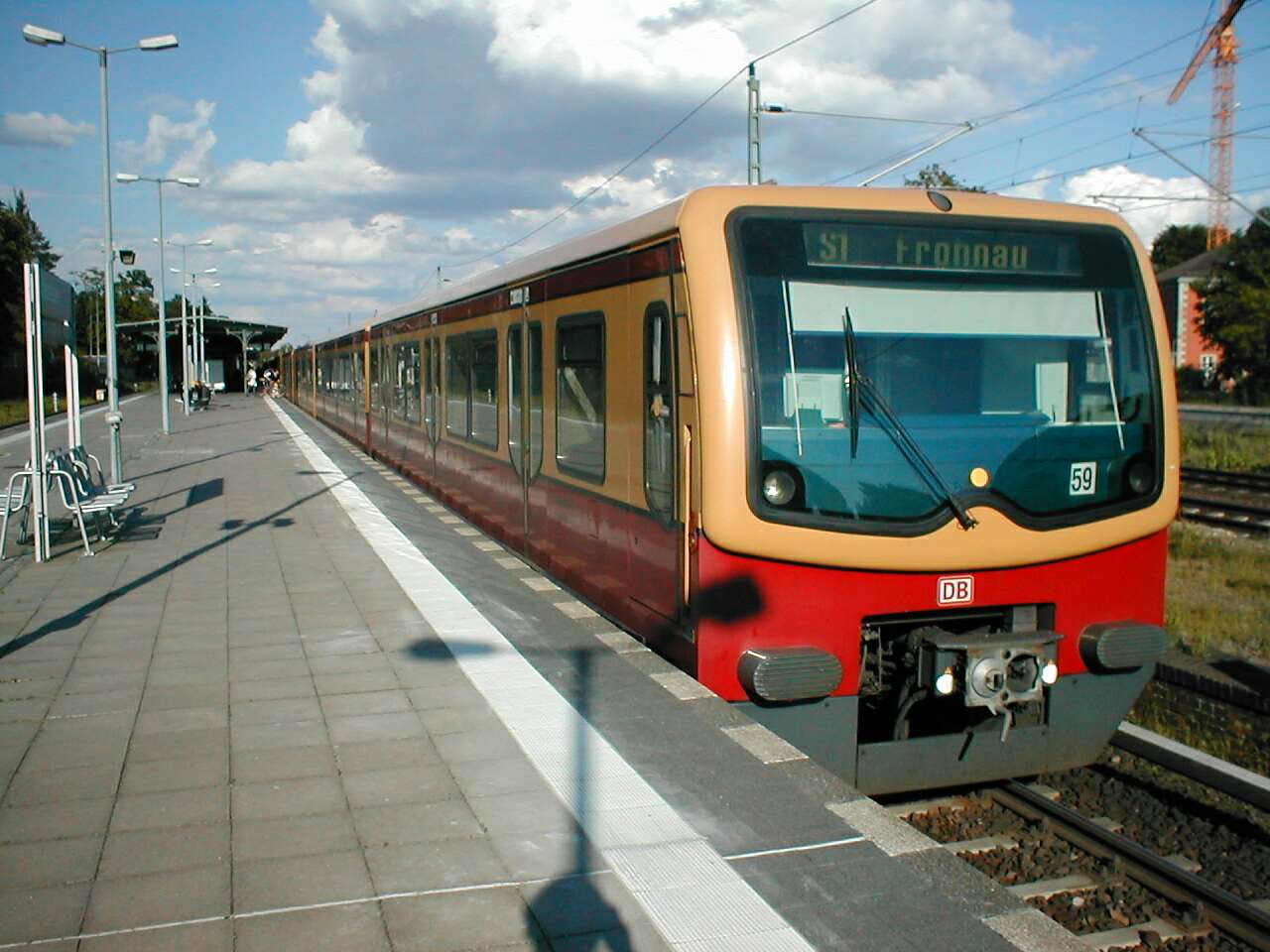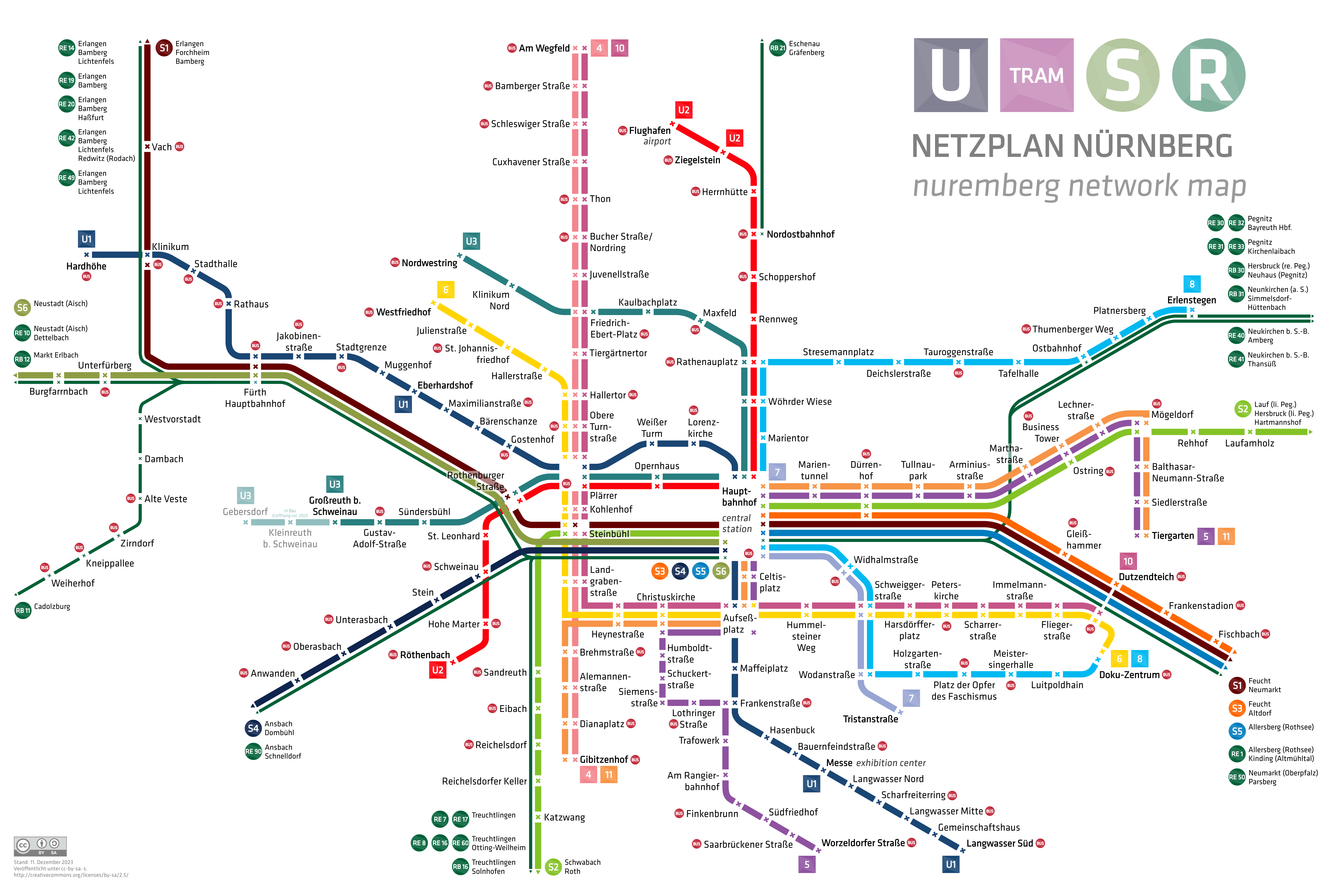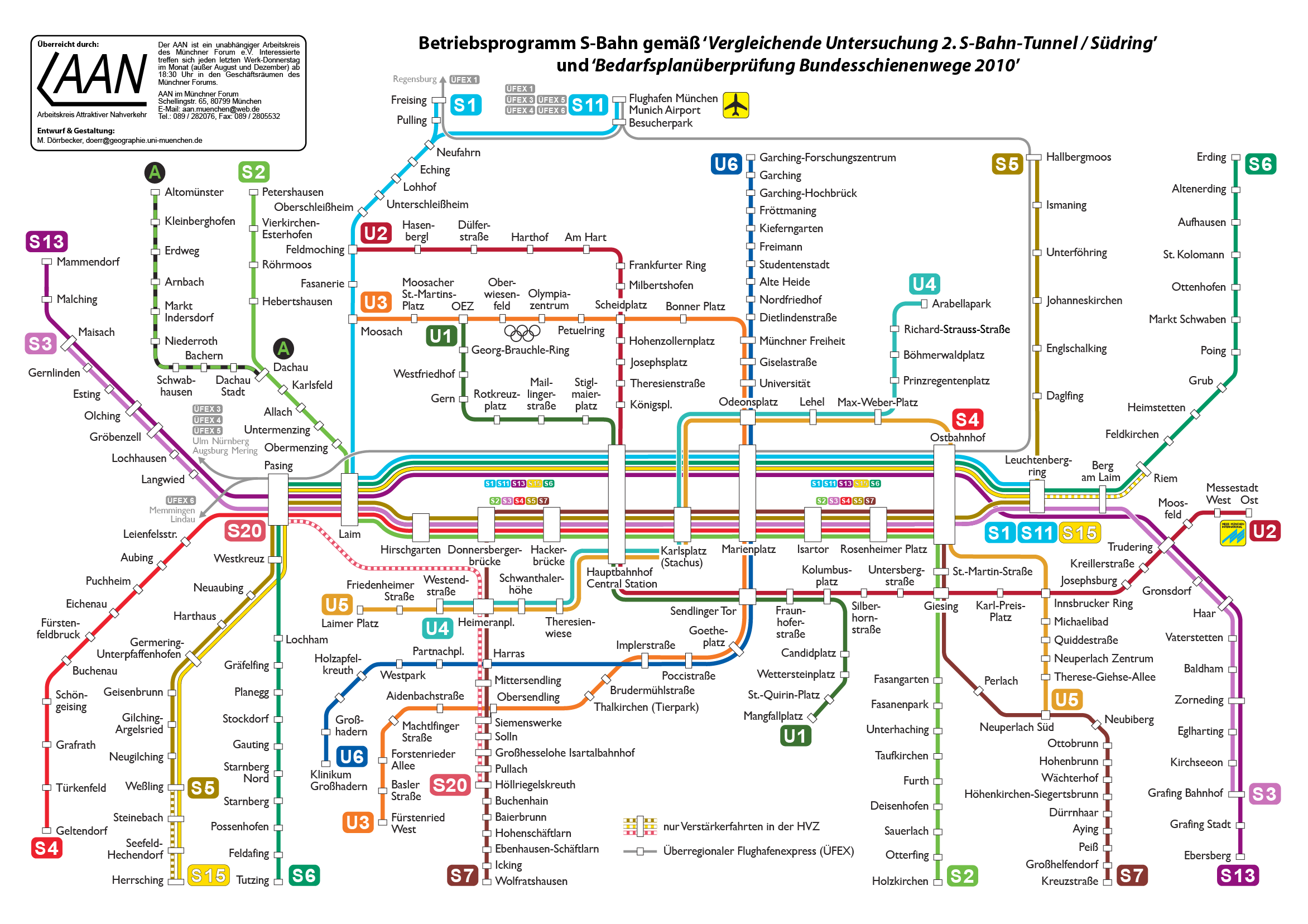|
U-Bahn
Rapid transit in Germany consists of four systems and 14 systems. The , commonly understood to stand for ('underground railway'), are conventional rapid transit systems that run mostly underground, while the or ('city rapid railway') are commuter rail services, that may run underground in the city center and have metro-like characteristics in Munich, Hamburg and Berlin which they only have to a lesser extent in other cities. There are also over a dozen semi-metro or systems that are rapid transit in the city center and light rail outside. There are four systems, namely in Berlin, Hamburg, Munich and Nuremberg; these are all run by the transit authorities in the city. Some cities call their "" (like Frankfurt) or abbreviate their with a U. The confusing term is also used on occasion and as is often seen as the more desirable term, common parlance and non-specialist media are often not very rigorous with the definition of their terms. Additionally, several cities in t ... [...More Info...] [...Related Items...] OR: [Wikipedia] [Google] [Baidu] |
Berlin U-Bahn
The Berlin U-Bahn (; short for , "underground railway") is a rapid transit system in Berlin, the capital and largest city of Germany, and a major part of the city's public transport system. Together with the Berlin S-Bahn, S-Bahn, a network of suburban train lines, and a Trams in Berlin, tram network that operates mostly in the eastern parts of the city, it serves as the main means of transport in the capital. Opened in 1902, the serves List of Berlin U-Bahn stations, 175 stations spread across nine lines, with a total track length of , about 80% of which is underground. Trains run every two to five minutes during peak hours, every five minutes for the rest of the day and every ten minutes in the evening. Over the course of a year, U-Bahn trains travel , and carry over 400 million passengers. In 2017, 553.1 million passengers rode the U-Bahn. The entire system is maintained and operated by the , commonly known as the BVG. Designed to alleviate traffic flowing into and out of c ... [...More Info...] [...Related Items...] OR: [Wikipedia] [Google] [Baidu] |
Nuremberg U-Bahn
The Nuremberg U-Bahn is a rapid transit system in Nuremberg and Fürth, Bavaria. It is operated by ''Verkehrs-Aktiengesellschaft Nürnberg'' (VAG; Nuremberg Transport Corporation), which itself is a member of the ''Verkehrsverbund Großraum Nürnberg'' (VGN; Greater Nuremberg Transport Network). The Nuremberg U-Bahn is Germany's newest metro system, having begun operation in 1972, although the Nuremberg-Fürth route (U1) uses part of the right of way of the Bavarian Ludwig Railway, Germany's first passenger railway opened in 1835. The current network of the U-Bahn is composed of three lines, serving 49 stations, and comprising of operational route, making it the shortest of the four metro systems in Germany, behind Berlin U-Bahn, Berlin, Hamburg U-Bahn, Hamburg and Munich U-Bahn, Munich. In 2008, driverless and fully automated trains were introduced on the new U3 line, making it Germany's first automatic U-Bahn line. U2 was converted to driverless operation by 2010, the first su ... [...More Info...] [...Related Items...] OR: [Wikipedia] [Google] [Baidu] |
Hamburg U-Bahn
The Hamburg U-Bahn is a rapid transit system serving the cities of Hamburg, Norderstedt, and Ahrensburg in Germany. Although referred to by the term U-Bahn (the "U" commonly being understood as standing for "underground"), most of the system's track length is above ground. The network is interconnected with the city's S-Bahn system, which also has underground sections. It is operated by Hamburger Hochbahn within the Hamburger Verkehrsverbund (HVV). It was opened in February 1912, and comprises four lines serving 93 stations, with a route length of in 2019. History In 1906 the Senate of Hamburg awarded a contract for the Elevated and Underground Railway to Siemens & Halske and AEG of Berlin. The first stretch was completed on 7 October 1906. This was followed in 1911 with the founding of the ''Hamburger Hochbahn Aktiengesellschaft'' (HHA). Thus Hamburg became the third German city (after Berlin, 1902 and Schöneberg, 1910) to have a U-Bahn (then known as the Elevated a ... [...More Info...] [...Related Items...] OR: [Wikipedia] [Google] [Baidu] |
Munich U-Bahn
The Munich U-Bahn () is an Railway electrification system, electric rail Rapid transit, rapid transit network in Munich, Germany. The system began operation in 1971, and is operated by the municipally owned Münchner Verkehrsgesellschaft (MVG; Munich Transport Company). The network is integrated into the Münchner Verkehrs- und Tarifverbund (MVV; Munich Transport and Tariff Association) and interconnected with the Munich S-Bahn. The U-Bahn currently comprises eight lines, serving 96 stations (100 stations if four interchange stations with separate levels for different lines are counted twice), and encompassing of routes. Alongside the S-Bahn, the Munich subway is the most important means of local public transport in Munich. Since the opening of the first line on October 19, 1971, a network with 95 km of track and 96 stops has been built, to which the neighboring town of Garching near Munich is also connected and in future also the Planegg district of Martinsried (both in the dist ... [...More Info...] [...Related Items...] OR: [Wikipedia] [Google] [Baidu] |
Rapid Transit
Rapid transit or mass rapid transit (MRT) or heavy rail, commonly referred to as metro, is a type of high-capacity public transport that is generally built in urban areas. A grade separation, grade separated rapid transit line below ground surface through a tunnel can be regionally called a subway, tube, metro or underground. They are sometimes grade-separated on elevated railways, in which case some are referred to as el trains – short for "elevated" – or skytrains. Rapid transit systems are usually electric railway, electric railways, that unlike buses or trams operate on an exclusive right-of-way (transportation), right-of-way, which cannot be accessed by pedestrians or other vehicles. Modern services on rapid transit systems are provided on designated lines between metro station, stations typically using electric multiple units on railway tracks. Some systems use rubber-tyred metro, guided rubber tires, magnetic levitation (''maglev''), or monorail. The stations typica ... [...More Info...] [...Related Items...] OR: [Wikipedia] [Google] [Baidu] |
Stadtbahn
(; German for 'city railway'; plural ) is a German word referring to various types of urban rail transport. One type of transport originated in the 19th century, firstly in Berlin and followed by Vienna, where rail routes were created that could be used independently from other traffic. In the 1960s and 1970s, ''Stadtbahn'' networks were created again but now by upgrading tramways or light rail lines. This process includes adding segments built to rapid transit standards – usually as part of a process of conversion to a metro railway – mainly by the building of metro-grade tunnels in the central city area. In the first years after the opening of the tunnel sections, often regular trams vehicles (but adapted for tunnel service) were used. These trams were followed by specially designed vehicles like the Stadtbahn B series. By the 1980s virtually all cities had abandoned the long-term goal of establishing a full-scale metro system due to the excessive costs associated with ... [...More Info...] [...Related Items...] OR: [Wikipedia] [Google] [Baidu] |
Hamburg S-Bahn
The Hamburg S-Bahn is a rapid transit railway system in the Hamburg Metropolitan Region. Together, the S-Bahn, the Hamburg U-Bahn, the AKN Eisenbahn, AKN railway and the regional railway form the backbone of railway public transport in the city and the surrounding area. The network has operated since 1907 as a commuter rail system, under the direction of the state railway, and is a member of the Hamburger Verkehrsverbund (HVV; Hamburg Transport Association). There are four lines, serving 68 stations, on of route. On an average working day the S-Bahn transports about 590,000 passengers; in 2010 about 221 million people used the S-Bahn. The S-Bahn is the only railway in Germany that uses both List of railway electrification systems#1200 V DC conductor, 1,200 V DC supplied by a third rail and supplied by overhead lines. Most of the tracks are separated from other rail services. The S-Bahn is operated by S-Bahn Hamburg GmbH, a subsidiary of DB Regio. Similarly to Berlin S-Bahn, Be ... [...More Info...] [...Related Items...] OR: [Wikipedia] [Google] [Baidu] |
Berlin S-Bahn
The Berlin S-Bahn () is a rapid transit railway system that services the reigon in and around Berlin, the capital city of Germany. It has been in operation under the name since December 1930, having been previously called the special tariff area ('Berlin city, orbital, and suburban railways'). It complements the Berlin U-Bahn and is the link to many outer-Berlin areas, such as Berlin Brandenburg Airport. As such, the Berlin S-Bahn blends elements of a commuter rail service and a rapid transit system. In its first decades of operation, the trains were steam-drawn; even after the railway electrification system, electrification of large parts of the network, some lines remained under steam. Today, the term ''S-Bahn'' is used in Berlin only for those lines and trains with Third rail, third-rail electrical power transmission and the special Berlin S-Bahn loading gauge. The third unique technical feature of the Berlin S-Bahn, the automated mechanical train control (works very similar ... [...More Info...] [...Related Items...] OR: [Wikipedia] [Google] [Baidu] |
Nuremberg S-Bahn
The Nuremberg S-Bahn () is an S-Bahn network covering the region of Nuremberg, Fürth and Erlangen which started operations in 1987 and is now integrated into the Greater Nuremberg Transport Association (Verkehrsverbund Großraum Nürnberg). The full length of the five current lines is about 277.6 kilometres. The S-Bahn trains are operated by DB Regio Mittelfranken, a subsidiary of DB Regio Bayern. From December 2018 the service was due to be taken over by National Express Germany; however, it withdrew from the bidding process on 25 October 2016, so the lines will continue to be operated by DB Regio Mittelfranken for the foreseeable future. The service between Fürth and Erlangen-Bruck has been marred by frequent delays and service restrictions due to the slow construction for four-track expansion. No completion date is given. The original plans for the upgrade of the Nuremberg Bamberg line to four tracks called for a new alignment of S-Bahn tracks east of the current two track ... [...More Info...] [...Related Items...] OR: [Wikipedia] [Google] [Baidu] |
S-Bahn
The S-Bahn ( , ), , is a hybrid urban rail, urban–suburban rail system serving a metropolitan region predominantly in German language, German-speaking countries. Some of the larger S-Bahn systems provide service similar to rapid transit systems, while smaller ones often resemble Commuter rail, commuter or even regional rail systems. The name ''S-Bahn'' derives from (), (, not to be confused with the present-day ''Stadtbahn'') or (). Similar systems in Austria and German-speaking Switzerland are known as S-Bahn as well. In Belgium, it is known as S-Trein (Flemish dialects, Flemish) or Train S (French language, French). In Denmark, they are known as S-tog , and in the Czech Republic as Esko or S-lines. In Milan, they are known as Milan S Lines, Linee S. S-Bahn is also a treated as a Train categories in Europe, train category in several European countries. Characteristics There is no complete definition of an S-Bahn system. S-Bahn are, where they exist, the most local typ ... [...More Info...] [...Related Items...] OR: [Wikipedia] [Google] [Baidu] |
S-Bahn Berlin Baureihe 481
The S-Bahn ( , ), , is a hybrid urban–suburban rail system serving a metropolitan region predominantly in German-speaking countries. Some of the larger S-Bahn systems provide service similar to rapid transit systems, while smaller ones often resemble commuter or even regional rail systems. The name ''S-Bahn'' derives from (), (, not to be confused with the present-day ''Stadtbahn'') or (). Similar systems in Austria and German-speaking Switzerland are known as S-Bahn as well. In Belgium, it is known as S-Trein (Flemish) or Train S ( French). In Denmark, they are known as S-tog , and in the Czech Republic as Esko or S-lines. In Milan, they are known as Linee S. S-Bahn is also a treated as a train category in several European countries. Characteristics There is no complete definition of an S-Bahn system. S-Bahn are, where they exist, the most local type of passenger train service that stops at all existing stations on mainline networks inside and around a city (while o ... [...More Info...] [...Related Items...] OR: [Wikipedia] [Google] [Baidu] |
Munich S-Bahn
The Munich S-Bahn () is an Railway electrification system, electric rail transit system in Munich, Germany. "S-Bahn" is the German abbreviation for ''Stadtschnellbahn'' (literally, "urban rapid rail"), and the Munich S-Bahn exhibits characteristics of both rapid transit and commuter rail systems. The Munich S-Bahn network is operated by S-Bahn München, a subsidiary of DB Regio Bayern, which is itself a subsidiary of the German national railway company, Deutsche Bahn. It is integrated into the Munich Transport and Tariff Association (''Münchner Verkehrs- und Tarifverbund'', MVV) and interconnected throughout the city with the locally owned Munich U-Bahn. Today, the S-Bahn covers most of the populated area of the Munich metropolitan area of about 3 million inhabitants. In terms of system length, the Munich S-Bahn is the fourth-largest in Germany, behind the Rhine-Neckar S-Bahn, Rhine-Ruhr S-Bahn and the S-Bahn Mitteldeutschland. The Munich S-Bahn was established on 28 May 1972. ... [...More Info...] [...Related Items...] OR: [Wikipedia] [Google] [Baidu] |








